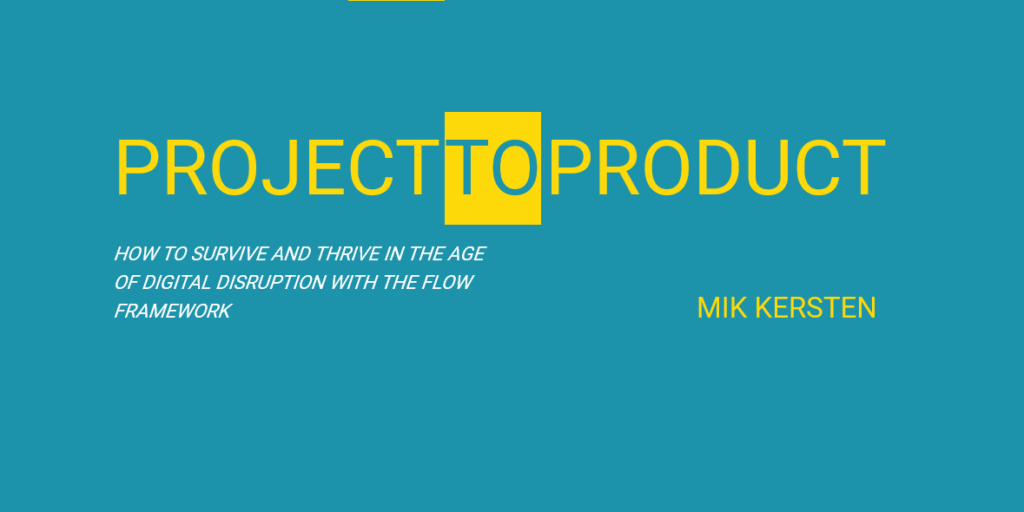Below is a brief excerpt from Project to Product: How to Survive and Thrive in the Age of Digital Disruption with the Flow Framework, a new book from Dr. Mik Kersten with a foreword written by Gene Kim. This snippet of the book discusses the Flow Framework–a new approach for connecting the business to technology, which bridges the gap between business strategy and technology delivery.
Today, enterprise organizations are attempting to use managerial mechanisms from previous ages to direct software delivery in this one. IT and software delivery costs have been growing for decades, yet our organizations do not have adequate visibility or understanding of what is now one of the largest costs of doing business. Meanwhile, the tech giants and digital startups have already mastered the managerial frameworks necessary to succeed in the Age of Software. So have many of the technologists working within enterprises, and these technologists are pushing hard on their organizations to deploy the DevOps and Agile practices that they know are critical to transformation.
The problem is that the principles of modern software-delivery approaches are not translating to the business. For example, enterprises are still managing IT as a set of projects or a cost center, rather than taking the product-oriented mentality that defined the winners of the Age of Mass Production.
We need our businesses to adapt to this product-oriented mind-set and to do so in a way that supports the vast differences between producing physical widgets and infinitely malleable software components. We need a new framework, one that elevates the best practices of Agile and Lean frameworks to the business. We need to define business out- come–oriented metrics instead of relying on activity-oriented proxy metrics.
The Flow Framework is a new approach for connecting the business to technology. The Flow Framework is not intended to help you spot market shifts or strategize offerings that will disintermediate disruptors; it is intended to provide you with a layer that bridges the gap between business strategy and technology delivery. The Flow Framework opens up the black box of IT so you can create an organization-wide feedback loop, accelerating the flow of business value to customers and the organizational learning to adapt as the market continues through the second half of the Age of Software.
By the time data is available to analysts and researchers it will be too late. The winners and losers of the Age of Software will have gained enough market share that those applying management techniques of previous ages will find it difficult or impossible to catch up without regulation or other forms of government intervention. We see signs of this already: whenever Amazon’s share price goes up, the share price of retailers like Target, Walmart, and Nordstrom’s goes down; and vice versa. This does not represent typical market dynamics. We are seeing a zero-sum game that will keep playing itself out industry by industry as we continue to head through the Turning Point.
Numerous methodologies and frameworks exist for transforming, modernizing, and reengineering every aspect of your business. Some, like the Scaled Agile Framework (SAFe), are focused on enterprise software delivery. Recent advances in DevOps practices address bottlenecks in how software is built and released. Other frameworks, like Moore’s Zone Management, address transformation from a business reengineering point of view.
Such practices and frameworks are as relevant as ever, and the Flow Framework assumes that the best-suited practices for your business are already underway. The role of the Flow Framework is to ensure that the business-level frameworks and transformation initiatives are connected to the technical ones. It is the isolation of these initiatives that is causing so many transformations to stall or to fail.
To achieve the Three Ways of DevOps—flow, feedback, and continuous learning—we need to scale the ways of DevOps beyond IT to the business. We need a new framework to plan, monitor, and ensure the success of today’s software-centric digital transformations. This new framework cannot be separate from the business; it must be connected directly to the measurement of business objectives and key results. It also cannot ignore the idiosyncrasies of software development or assume that software can be managed like manufacturing. And it cannot be overly focused on one aspect of software delivery, be that development, operations, or customer success.
The new framework must encapsulate the management of large- scale software delivery in a similar way to how value stream mapping, enterprise-request processing, and supply-chain management provided the managerial building blocks needed to master manufacturing. This is the role of the Flow Framework.
In today’s enterprise IT organizations, not just the staff but the leadership have problems answering the questions most fundamental to production:
- Who is the customer?
- What value is the customer pulling?
- What are the value streams?
- Where is the bottleneck?
The Flow Framework provides a simple path to answering these questions. There are key staff within your organization who already know the answers, but their efforts and vision need to be connected to an organizational strategy and approach. Most important, it provides you with a way of connecting your Value Stream Network, measuring the flow of business value and correlating that to your strategy and business outcomes. The Flow Framework will allow you to:
- See the end-to-end flow of business value in real time
- Instantly spot bottlenecks and use them to prioritize investment
- Test hypotheses based on real-time data from every value stream
- Rearchitect your organization around maximizing flow
A digital organization that competes without a connected and visible Value Stream Network will become akin to a manufacturer trying to compete in the last age without an electrical network. These organizations will learn that managing IT without flow metrics or something equivalent is like managing a cloud infrastructure without a mechanism for measuring the cost of electricity and computer power.
A large gap exists between what technologists have learned about effective software delivery and how businesses approach software projects. While DevOps and Agile principles have made a significant impact on how technologists work, they have been overly technology centric and have not been adopted broadly by business stakeholders. To bridge the gap, we need a new kind of framework that spans the language of the business with the language of technology and enables the transition from project to product. We need that framework to scale the three ways of DevOps—flow, feedback, and continuous learning—to the entire business. This is the goal of the Flow Framework.
You can learn more about Dr. Mik Kerston, the book Project to Product: How to Survive and Thrive in the Age of Digital Disruption with the Flow Framework, and where you can buy it by visiting the Project to Product website.
- Rethinking Cybersecurity in the Age of AI and Digital Twins - August 25, 2025
- 10 Clever Tech Gadgets Every Student Will Actually Use - August 21, 2025
- The Evolving Face of Ransomware — and How We Can Stay Ahead of It - August 15, 2025




Comments are closed.